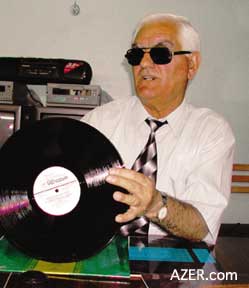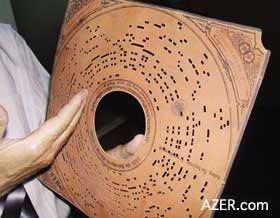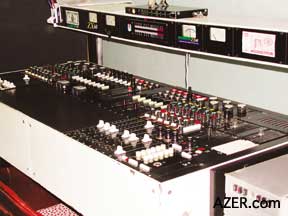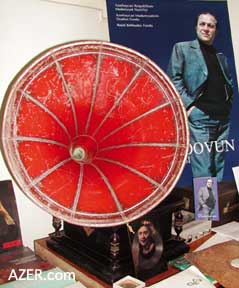|

Autumn 2002 (10.3)
Pages
70-71
Voices from the Past
Treasures
from Azerbaijan's Voice Recording Archive
by Yagub Madatov
  Left: Yagub Madatov, Director, who has worked at the
Archives for the past 35 years during which time the collection
has gathered more than 50,000 voice items related to Azerbaijan's
history. Photo: Blair. Left: Yagub Madatov, Director, who has worked at the
Archives for the past 35 years during which time the collection
has gathered more than 50,000 voice items related to Azerbaijan's
history. Photo: Blair.
Nothing from history
speaks to us quite so profoundly as the human voice itself. Reading
handwritten pages of thumb-worn diaries or looking at faces in
a photo albums may be revealing, but there's something much more
immediate and personal about listening to the sound of a person's
voice.
Recordings of the voices of
many famous Azerbaijanis are housed at the Azerbaijan Republic
State Voice Recording Archive, including those of composer Uzeyir
Hajibeyov (1885-1948), Tabrizi poet Shahriyar (1907-1987) and
the founder of the Azerbaijan Democratic Republic, Mammad Amin
Rasulzade (1884-1955). Also included in the archive's 50,000
- plus audio recordings are well-known khanande [traditional
singers] from the early 20th century. Here Yagub Madatov, Director
of the Voice Recording Archive, explains how he and his staff
have put together this unique archive as a way of preserving
historic recordings for future generations.
______
Voice Recording Archives
  Left: A 19th-century thick cardboard record made for
a German manufactured recorder called the Hemophone. This record
is a Strauss piece and belonged to the writer Akhundov (1812-1878).
The Archive has no Hemophone and archivists working there have
never heard this record played. Photo: Blair. Left: A 19th-century thick cardboard record made for
a German manufactured recorder called the Hemophone. This record
is a Strauss piece and belonged to the writer Akhundov (1812-1878).
The Archive has no Hemophone and archivists working there have
never heard this record played. Photo: Blair.
Our generation is familiar
with Azerbaijani greats like composer Uzeyir Hajibeyov (1885-1948),
singer Rashid Behbudov (1915-1989) and poet Samad Vurghun (1906-1956).
But we need to ask ourselves the question whether 50 years from
now, Azerbaijanis will be able to remember anything other than
their names?
Such personalities are a vital part of our history, and it's
up to us to enable future generations to remember them. Here
at the Voice Recordings Archive, we work to preserve Azerbaijan's
culture, art and history through audio recordings. These recordings
represent living history. And who knows? Some of them might hold
valuable information for researchers in the future. Naturally,
we try to archive everything. Our archive was created according
to a governmental resolution that says we cannot delete anything
from the archive.
Already, we have more than 50,000 audio recordings related to
Azerbaijan, including vinyl records, cassette tapes, CDs and
some videos. Especially rare are the archive's 500 or more vinyl
recordings of classic mugham singers from the early 20th century
that were recorded between the years 1902 and 1914.
Preserving History
The Azerbaijan SSR decided to open up its own Voice Recordings
Archive back in 1968. Another such archive had been opened in
Moscow the previous year. Called the Voice Recordings Archive
of USSR, it served as a repository for recordings from all over
the Soviet Union and included the voice of every performer who
had ever been honored as "People's Artist of the USSR"
and every deputy of the USSR Supreme Soviet.
Our archive, on the other hand, focused specifically on Azerbaijan.
To this day, none of the other former Soviet Republics have opened
an archive like ours. Today, the Voice Recording Archive is the
most recent of seven archives functioning under the umbrella
of the Head Archives Department under the Cabinet of Ministers
of Azerbaijan. I was fortunate to be involved with the archive
from its very creation, along with several other enthusiastic
students who had been recruited from the Azerbaijan (now Baku)
State University and the Academy of Sciences. We started everything
from scratch nearly 35 years ago. At the time, our main source
was the recordings of the State TV and Radio Company. We had
our pick of the programs from whatever was shown on television.
According to the governmental resolution, the Radio and Television
Archive would make a copy for themselves and then send us the
original document for official preservation. We also carried
out research in Azerbaijan's various regions, where villagers
are recognized for their deep knowledge of folklore. We found
examples of laylas (lullabies), folk tales, meykhanas (the Azerbaijani
version of rap) and dances from each region.
  Left: Much of the sound equipment in the Archive is
decades old and quite outdated. Left: Much of the sound equipment in the Archive is
decades old and quite outdated.
We also interviewed
famous Azerbaijanis, including heroes of the Soviet Union, heroes
of Socialist Labor, Academicians, "People's Writers"
and "People's Artists". This was during the Soviet
era, so we didn't focus on politics or the government. Instead,
we asked the people to talk about their own interests, about
their lives and creations - what they really felt inside. From
their voices, you can tell that the answers were sincere.
I've been doing this type of work for more than three decades,
and from my experience, I've learned that the voice affects the
way one thinks. For example, if you hear a very smooth, nice
voice, you take it for granted. But if you work with the sound
of that voice for a long time, just hearing someone else being
rude to a child can hurt you. For example, every time I hear
the voice of Hajibeyov or Vurghun, it sounds like music to my
ears. But if I go to the street and hear harsh words, it's painful
to me. The people around me know that I'm a very sensitive person.
A single word can pain me.
Rare Finds
A very exciting part of our collection features the recordings
of khanande from the early 20th century. For instance, we have
a 1908 recording of Kechachi oghlu Mahammad; he had a very unique
voice. There is also one of Jabbar Garyaghdi oghlu, who was the
most famous of all Azerbaijani khanandas. These were recorded
here, manufactured in France, England and Poland and then brought
back to Azerbaijan.
  Some of these recordings have been restored
and transferred to compact discs. This process is very complicated.
Suppose we want to create a series of recordings by singer Shovkat
Alakbarova (1922-1993). She has vinyl records of varying quality
- for example, the quality of her records from 1960s invariably
are superior to those made in the 1950s. We have to re-record
them on a tape so that the final recording is of equal quality.
After we enter these recordings into the computer, we create
CDs. We don't sell these CDs; we just store them here and make
them available for listening. Some of these recordings have been restored
and transferred to compact discs. This process is very complicated.
Suppose we want to create a series of recordings by singer Shovkat
Alakbarova (1922-1993). She has vinyl records of varying quality
- for example, the quality of her records from 1960s invariably
are superior to those made in the 1950s. We have to re-record
them on a tape so that the final recording is of equal quality.
After we enter these recordings into the computer, we create
CDs. We don't sell these CDs; we just store them here and make
them available for listening.
One of the oldest objects in our collection is a cardboard record
that once belonged to writer and alphabet reformer Mirza Fatali
Akhundov (1812-1878). This recording is of a polka - mazurka
and a fragment from the Strauss opera "The Gypsy Baron";
it was created for a German-manufactured record player called
a herophone, which is now obsolete. We know that the record was
once part of Akhundov's collection because it has his handwriting
on it and came to us from his home museum in Shaki. Unfortunately,
we can't play it because we don't have a herophone.
Researchers are welcome to visit and listen to the recordings
here at the Archive. We simply ask them to bring a letter that
describes the topic they are working on. We have two kinds of
catalogues, one organized by name and another organized by general
category. We also have specific collections, such as the Uzeyir
Hajibeyov collection.
Above:
Part of the Voice Archives
Collection on display in a small exhibit room. Poster is of Rashid
Behbudov, famous singer from 1940s to 1980s. Early gramaphone
and plastic record.
Today's Obstacles
We moved into our current building in 1995. It has eight stories,
five of which are used for storing the recordings. The building
was designed specifically to be an archive.
Right now, we have 18 employees. We are not able to fully utilize
our work resources because we have limited equipment. For instance,
our sound equipment is quite obsolete; some of the tape recorders
date back to the 1960s.
We only have one computer, which is used for both administrative
and archival tasks. Obviously, not all of the employees can work
on the computer at the same time. Even having just one more computer
would be very helpful; then we would be able to employ more people
and get a lot more work done.
Despite these frustrating challenges, we still feel a deep responsibility
to help preserve Azerbaijan's culture, art, history and literature.
By continuing to expand the collection and preserving these voice
recordings to the best of our ability, we give future generations
of Azerbaijanis the opportunity to listen to these rare recordings
made so many years ago.
Yagub Madatov is the Director
of the Voice Recording Archives where he has worked for the past
35 years.
The Voice Recording Archive is located at 168 Azadlig Prospect,
Baku. Tel: (994-12) 63-02-94.
The Discography Web site of the Voice Recording Archive is at
DISKOGRAPHIA.aznet.org. This site (in English and Azeri Latin)
lists more than 500 examples of Azerbaijani folk songs, mughams
and folklore that were recorded between the early 1900s and 1950s.
____
Back to Index
AI 10.3 (Autumn 2002)
AI Home
| Search | Magazine
Choice
| Topics
| AI Store | Contact us
Other Web sites
created by Azerbaijan International
AZgallery.org | AZERI.org | HAJIBEYOV.com
|




